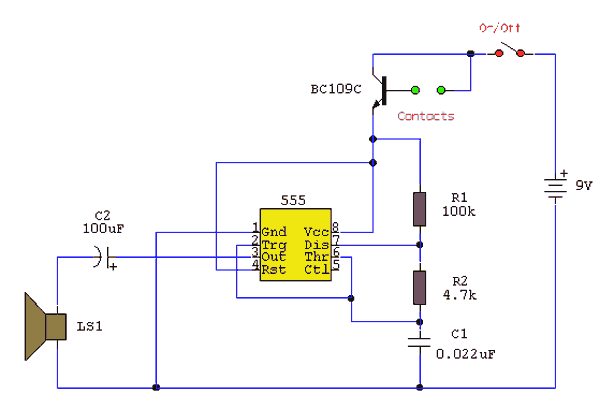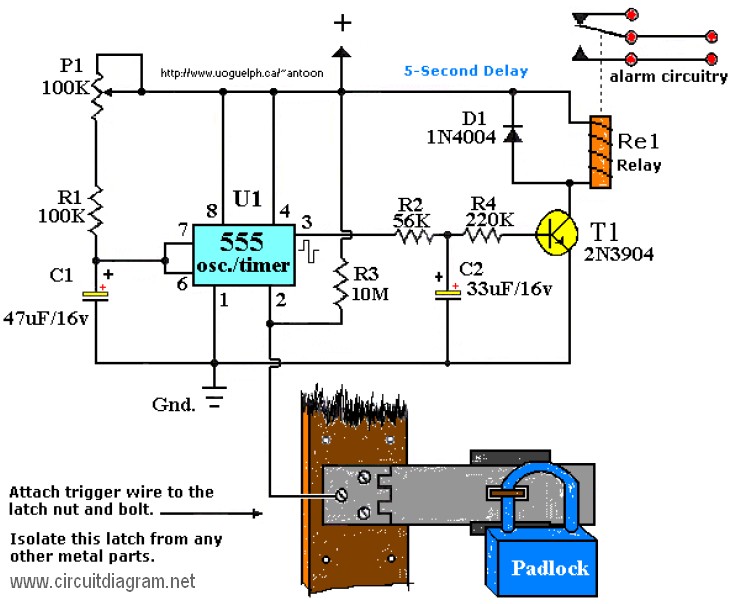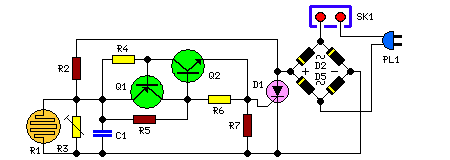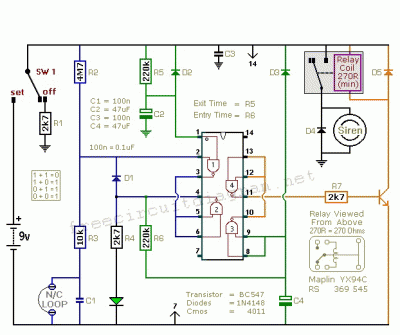
water activated alarm

Under dry conditions, the transistor will not have any bias current and will be completely off. However, when the probes become wet, the transistor will conduct, triggering the alarm. An On/Off switch is included, and it is important to use a non-reactive metal for the probe contacts. Gold or silver-plated contacts from an old relay can be utilized, but a cost-effective alternative is to connect copper strips from a piece of veroboard. Although these will eventually oxidize, the low current flowing in the base circuit means that the increased impedance due to oxidation is not a significant concern. A base resistor is unnecessary since the transistor operates in an emitter follower configuration, with the current limit determined by the impedance at the emitter, which is part of the oscillator circuit.
The described circuit utilizes a transistor as a sensing element in a moisture detection system. In its default state, the transistor remains off, preventing current flow and thereby keeping the alarm inactive. The critical component of this design is the moisture-sensitive probes, which, when exposed to water, initiate the conduction of the transistor. This conduction allows current to flow through the alarm circuit, effectively signaling the presence of moisture.
The inclusion of an On/Off switch provides the user with control over the operation of the circuit, enabling it to be deactivated when not in use. The choice of probe materials is crucial for the longevity and reliability of the system. Non-reactive metals such as gold or silver are preferred due to their resistance to corrosion and oxidation, which can affect conductivity over time. However, in cost-sensitive applications, copper strips can serve as a viable alternative. While copper is prone to oxidation, the low current in the circuit mitigates the potential impact of increased resistance.
The emitter follower configuration of the transistor allows for a direct connection to the load while maintaining a high input impedance. This configuration eliminates the need for a base resistor, as the transistor's operation is primarily determined by the emitter's impedance. The oscillator circuit connected to the emitter limits the current flowing through the transistor, ensuring safe and efficient operation.
Overall, this moisture detection circuit is designed for simplicity and effectiveness, making it suitable for various applications where water presence needs to be monitored. Proper selection of materials and circuit configuration enhances reliability and performance, making it an effective solution for moisture detection.Under dry conditions, the transistor will have no bias current and be fully off. However as the probes get wet the transistor will conduct and sounding the alarm. An On/Off switch is provided and remember to use a non-reactive metal for th e probe contacts. Gold or silver plated contacts from an old relay may be used, however a cheap alternative is to wire alternate copper strips from a piece of veroboard. These will eventually oxidize over but as very little current is flowing in the base circuit, the higher impedance caused by oxidization is not important.
No base resistor is necessary as the transistor is in emitter follower, current limit being the impedance at the emitter (the oscillator circuit). 🔗 External reference
The described circuit utilizes a transistor as a sensing element in a moisture detection system. In its default state, the transistor remains off, preventing current flow and thereby keeping the alarm inactive. The critical component of this design is the moisture-sensitive probes, which, when exposed to water, initiate the conduction of the transistor. This conduction allows current to flow through the alarm circuit, effectively signaling the presence of moisture.
The inclusion of an On/Off switch provides the user with control over the operation of the circuit, enabling it to be deactivated when not in use. The choice of probe materials is crucial for the longevity and reliability of the system. Non-reactive metals such as gold or silver are preferred due to their resistance to corrosion and oxidation, which can affect conductivity over time. However, in cost-sensitive applications, copper strips can serve as a viable alternative. While copper is prone to oxidation, the low current in the circuit mitigates the potential impact of increased resistance.
The emitter follower configuration of the transistor allows for a direct connection to the load while maintaining a high input impedance. This configuration eliminates the need for a base resistor, as the transistor's operation is primarily determined by the emitter's impedance. The oscillator circuit connected to the emitter limits the current flowing through the transistor, ensuring safe and efficient operation.
Overall, this moisture detection circuit is designed for simplicity and effectiveness, making it suitable for various applications where water presence needs to be monitored. Proper selection of materials and circuit configuration enhances reliability and performance, making it an effective solution for moisture detection.Under dry conditions, the transistor will have no bias current and be fully off. However as the probes get wet the transistor will conduct and sounding the alarm. An On/Off switch is provided and remember to use a non-reactive metal for th e probe contacts. Gold or silver plated contacts from an old relay may be used, however a cheap alternative is to wire alternate copper strips from a piece of veroboard. These will eventually oxidize over but as very little current is flowing in the base circuit, the higher impedance caused by oxidization is not important.
No base resistor is necessary as the transistor is in emitter follower, current limit being the impedance at the emitter (the oscillator circuit). 🔗 External reference





